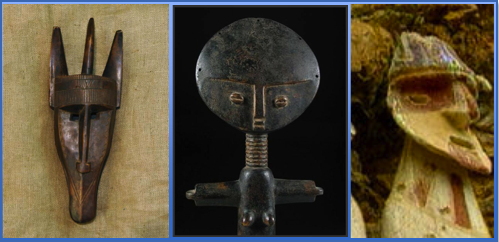 |
| Image property of History Channel |
A year and a half ago, my husband and I trekked four days along the Incan trail to Machu Picchu. Prior to this trip the only history of the area that I knew was of the Incas. Being an Art History major with a specialty in "non-western" art, I am ashamed to say as I watched the documentary that the Chachapoya were a people completely unknown to me. The majority of the film follows Dr. Keith Muscutt of the University of CA, Santa Cruz on his 15 year quest to find an undisturbed Chachapoya burial site.
 |
Tombs in the Cliff "Diablo Huasi"
(©Adriana von Hagen)
|
 |
|
Dogon Mask (source:
GenuineAfrica.com),
Ashanti Akuba Doll (source:
randafricanart.com),
Chachapoya funeral guard (source:
HistoryChannel.com)
|
The high broad forehead, thin
straight nose and oval eyes can be found on all three statues. For the
woman who commissioned the Akuba dolls, these traits represented their ideal
beauty. Since the Akuba dolls were used by woman as a sort of fertility
charm, it's only fitting that the image would represent the ideal beauty.
What I find interesting, and why I've compared the Chachapoya statue to
African statues is that typical Incan humanoid statues do not share these
physical traits.
 |
|
Statue from
"1000
Years of Incan
Gold"
Source: silviahartmann.com
|
 |
|
Pre-Incan
statue @ San Augstin
Archeological
Park
Source: posterlounge.co.uk
|
Why would a culture, such as the
Chachapoya, develop such a different artistic style from the cultures that
surrounded it. And why would their style emulate culture which were thousands
of miles away? I don't have an answer just a series of theories, one of
which includes ancient air travel. Not probable I realize but it would
definitely help to explain occurrences such as these.
No comments:
Post a Comment